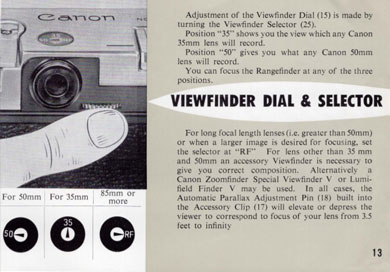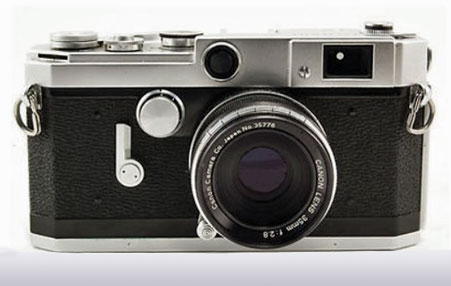Canon VL, VL2 Cameras 1957-1958
A Description of the Canon VL and VL2 Cameras of 1957-1958

Canon VL with standard 50mm f1.8
Introduction of the Canon VL and VL2
The Canon VL and VL2 were introduced at the beginning of 1958, and their production was limited to that year. Both of these cameras feature lever film advance, which was to prove favored by photographers over the trigger advance promoted by Canon throughout the 1950s. These models also were the first with Canon's new metal foil shutter curtain. The metal foil would avoid the potential curtain holes when the rangefinder was left lens-up in the sun, with the sun's rays focused on the curtain.
The Canon VL and VL2 had a new viewfinder with silver-coated optics, which have kept their transparency well over the years. 1 As the instruction manual illustrated, the viewfinder could be selected for either 35mm lens image or 50mm, or for more precise range-finding, and 'RF' position.

Automatic Parallax Correction
As well as a quality viewfinder for 35mm and 50mm lenses, these cameras featured automatic parallax correction of accessory viewfinders. The center of the accessory shoe included a pin which would rise and lower as the rangefinder was focused. This pin would mate with a similar pin in the base of a new range of accessory finders offered by Canon. The accessory finder would also rise and lower, activated by the pin in the accessory shoe giving automatic parallax correction - a feature unique to Canon.

Canon VL2
Introduced also in January 1958 was the Canon VL2. This camera was basically the same as the Canon VL, but was the economy version. It lacked the top speed of 1/1000 second of the VL. This was primarily a marketing decision, since the shutters of the two cameras were identical. It was also sold with the more economical Canon 50mm f2.8 lens. The VL with a Canon 50mm f1.2 lens sold for 89,000 Yen. The economical Canon VL2 sold for 58,000 Yen with the 50mm f2.8 lens.

a 1958 Canon VL2 with the economical 50mm f2.8 lens
The Canon VL2 outsold the Canon VL, selling 8,450 units during 1958, compared with the Canon VL sales of 5,450 units. The viewfinders and shutters of these cameras proved very reliable over the years, and would be fine 'user' cameras, except for the high prices bid up in secondary markets by collectors.
Succession of the Canon VL and VL2
The Canon VL and VL2 production did not extend beyond 1958 because of Canon's plans to introduce a new camera shutter. This was the shutter controlled by a single non-rotating dial. No more low speed and high speed shutter dials. The single shutter speed dial was already featured on the Nikon Model SP of 1957 and the Leica M3 of 1953. Canon's new shutter was introduce in late 1958 on the Canon VI-L and VI-T.
You can click on the links in the table below to consult other pages of the canonrangfinder.org site.
| Navigation: Click Below to Jump to Desired Subject Page | ||
|---|---|---|
| Canon Rangefinder Cameras - 1 | Canon Rangefinder Cameras - 2 | Canon Rangefinder Lenses |
| Canon S | Canon IVSB2 | Canon 19mm |
| Canon J | Canon IIS2, IID2, IIF2 | Canon 25mm |
| Canon NS | Canon VT, Canon L2 | Canon 28mm |
| Canon JS | Canon L1, L3 | Canon 35mm |
| Canon J-II | Canon VT Deluxe | Nikkor 50mm |
| Canon S-II | Canon VL, VL2 | Canon 50mm |
| Canon IIB | Canon VI-L, VI-T | Canon 85mm |
| Canon III, IIC, IV | Canon P | Canon 100mm |
| Canon III, IIC, IV | Canon 7 | Canon 200mm-1000mm |
| Canon IIIA, IVF, IVS | Canon 7s | Canon Accessories |
| Canon IIA, IID, IID1 | Nicca Rangefinders | Canon Finders |
| Canon IVSB | Leotax Rangefinders | Minolta Rangefinders |
| Canon IIF, IIS | Other Rangefinders | Minolta Lenses |
| Comparison Canon - Nikon Rangefinders | other M39 lenses | |
| Go to canonrangefinder.com home page | ||
Any additions or corrections to these pages would be welcome simply by contacting this site as shown at the foot of this page .
Footnotes:
1 Dechert, Peter. Canon Rangefinder Cameras 1933-1968. Hove Collectors Books. West Sussex, United Kingdom. 1985. ISBN 0-906447-30-5.
Peter Dechert's book is the most important expert source of information regarding Canon Rangefinder Cameras.
2 Kitchingman, Peter. Canon M39 Rangefinder Lenses 1939-1971. A Collector's Guide. Published by Peter Kitchingman. Perth, Australia. 2008. ISBN 978-0-646-48144-9.
Peter Kitchingman's book is the definitive study of the more than three decades of M39 format camera lenses developed for Canon Rangefinder Cameras.
3 Nostalgic Canon Camera Book. 懐かしいキヤノン EI Publishing Co. Ltd. Tokyo, Japan. June 2003.
Peter Kitchingman's book is the definitive study of the more than three decades of M39 format camera lenses developed for Canon Rangefinder Cameras.
4 "Canon Camera Museum" history website. https://global.canon/en/c-museum/history/ published by Canon, Inc. accessed in 2019.
5 Rajner, Hans P. (author), John Wade (editor). Leica Copies. Classic Collections Publications. London, UK. ISBN 13: 9781874485056
Hans P. Rajner's book is an excellently detailed and carefully researched study of camera from around the world which used the Leica M39 lens mount and the same lens to film plane distance.
7 Dechert, Peter. Canon Single Lens Reflex Cameras 1959-1991. Historical Camera Publications. Yakima, Washington. 1992. ISBN 1-879561-04-2.
8 Tomlinson, Shawn M. The Film Photography Book. Lulu Pulbications. 2016. ISBN: 9781365263972
9 Sartorius., Ghester. Identifying Leica Lenses. Classic Camera 19. Tokyo, Japan. 2001. ISBN 4-257-12029-0
10 website http://www.nicovandijk.net/rflensmatrix.htm consulted 2019.
11 O'Reagan, Douglas M. Allied Exploitation of German Science after World War II. Johns Hopkins University Press. Baltimore, Maryland. 2019. ISBN 9781421428888
12 website www.canonrangefinder.servehttp.com consulted 2008.
13 Minolta expert Andrea Aprà has posted information on minoltarangefinders group and other groups and further detailed information by email. (thanks Andrea !)
14 website http://www.collection-appareils.fr/objectifs/ consulted 2019.
15 Small, Marc James. Non-Leitz Leica Thread-Mount Lenses. Wittig Books. Hückelhoven, Germany. 1997. ISBN 3-930359-47-2.
16 the Nikon Corporation website: https://imaging.nikon.com/history/ consulted 2019.
17 p 152. Ray, Sidney F. Photographic Lens ISBN 9780240510323
18 website http://www.rokkorfiles.com/Lens%20History.html accessed 2019
19 Katz, Jerome. The Kardon camera story: a dedication to Peter Kardon, great American patriot & pioneer. SJF Enterprises. New York, New York. 1977.
20 Baird, John. The Japaneese Camera. The History of the Japanese Camera Monograph Collection. Historical Camera Publications. Yakima, Washington. 1990. ISBN 1-879561-02-6.
21 interesting website http://www.topgabacho.jp/Topconclub/Leotax.htm accessed 2019
22 Alexander, Jeffrey Scott. Nikon and the sponsorship of Japan's optical industry by the Imperial Japanese Navy 1923-1945. MA Thesis. University of British Columbia. 2001.
23 Alexander, Jeffrey Scott. Nikon and the sponsorship of Japan's optical industry by the Imperial Japanese Navy 1923-1945. PhD Thesis. University of British Columbia. 2010.
24 Lewis, Gordon, editor. Fujimura, Amy and Fujimura, William, translators. The History of the Japanese Camera. International Museum of Photography at George Eastman House. Tokyo and Rochester. 1991. ISBN 0-935398-17-1.
25 Rotoloni, Robert. Nikon Rangefinder Camera: An Illustrated History Hove Books Ltd. Sussex, UK. 1993. ISBN-13: 978-1874707073
26 Eastland, Jonathan. Dr. Leica M Compendium: Handbook of the Leica-M System Hove Books Ltd. Sussex, UK. 2006. ISBN-13: 9781897802052
If you have any comments or questions about this Canon Rangefinder site, please e-mail me (Larry Huffman) at e-mail address: [email protected]